SymPy vs. Yacas - sympy/sympy GitHub Wiki
 vs.
vs. 
SymPy and Yacas are Computer algebra systems.
- Computer Algebra System
-
A software program that facilitates symbolic mathematics. The core functionality of a CAS is manipulation of mathematical expressions in symbolic form.
Sympy is a Python library for symbolic computation that aims to become a full-featured computer algebra system and to keep the code simple to promote extensibility and comprehensibility.
SymPy was started by Ondřej Čertík in 2005 and he wrote some code in 2006 as well. In 11 March 2007, SymPy was realeased to the public. The latest stable release of SymPy is 0.7.1 (29 July 2011). As of beginning of December 2011 there have been over 150 people who contributed at least one commit to SymPy.
SymPy can be used:
- Inside Python, as a library
- As an interactive command line, using IPython
SymPy is entirely written in Python and does not require any external libraries, but various programs that can extend its capabilites can be installed:
- gmpy, Cython --> speed improvement
- Pyglet, Matplotlib --> 2d and 3d plotting
- IPython --> interactive sessions
SymPy is available online at SymPy Live. The site was developed specifically for SymPy. It is a simple web shell that looks similar to iSymPy under the standard Python interpreter. SymPy Live uses Google App Engine as computational backend.
+ +: small library, pure Python, very functional, extensible, large community.
- -: slow, needs better documentation.
Yacas is a small and highly flexible general-purpose computer algebra system and programming language. The name is an acronym for Yet Another Computer Algebra System. Yacas is a program for symbolic manipulation of mathematical expressions.
It uses its own programming language, designed for symbolic as well as arbitrary-precision numerical computations. The system has a library of scripts that implement many of the symbolic algebra operations. New algorithms can be easily added to the library.
Yacas was created by Ayal Pinkus et al. in 1998. The latest stable release of Yacas is 1.3.1 (25 October 2011). Yacas is written entirely in C++.
Yacas is primarily intended to be a research tool for easy exploration and prototyping of algorithms of symbolic computation. The main advantage of Yacas is its rich and flexible scripting language.
It is possible to try Yacas online at the My Yacas section of Yacas' official site.
+ +: small library, very functional, flexible.
- -: slow, needs better documentation, small community.
Both SymPy and Yacas are cost free open source CASes. SymPy is released under a modified BSD license, while Yacas is realeased unde the GNU GPL.
One of the differences between SymPy and Yacas is that Yacas has a GUI for Windows platforms called GUYacas. This program is selfcontainted, meaning that it isn't necessary to install Yacas for GUYacas to work. However, GUYacas requires that 'Microsoft .NET Framework Version 2.0' is installed.
| System | Windows | Mac OS X | Linux | BSD | Solaris |
|
|
|
|
|
Yes |
|
|
|
|
|
|
Yes |
|
|
Sympy is distributed in various forms. It is possible to download source tarballs and packages from the Google Code page but it is also possible to clone the main Git repository or browse the code online. The only prerequisite is Python since Sympy is Python-based library. It is recommended to install IPython as well, for a better experience.
Yacas is small (1.2 MB) and portable across most Unix-like platforms and requires a standard C++ compiler such as g++. Precompiled Red Hat (RPM) and Debian (DEB) packages are also available. To compile and install Yacas, read the file INSTALL. There are two methods to compile and install Yacas: downloading a tarball or downloading from CVS at SourceForge.
| System |
Formula editor |
|
|
|
|
|
|
|
|
|
|
|
|
|
| System + |
|
Graph theory |
Number theory |
Quantifier elimination |
Boolean algebra |
Tensors |
|
|
|
|
|
|
|
|
|
|
|
|
|
|
* Will be available in SymPy 0.7.2
In SymPy, to raise something to a power, you must use **, not ^ as the latter uses the Python meaning, which is xor.
In [1]: (x+1)^2
---------------------------------------------------------------------------
TypeError Traceback (most recent call last)
/home/aoi_hana/sympy/<ipython-input-6-52730bce1577> in <module>()
----> 1 (x+1)^2
TypeError: unsupported operand type(s) for ^: 'Add' and 'int'
In [2]: (x+1)**2
Out[2]:
2
(x + 1)However, in Yacas, you must use ^ for exponentiation, as ** isn't defined as an operator:
In> (x+1)**2
String(1) : Error parsing expression, near token **
In> (x+1)^2
Out> (x+1)^2Another difference between SymPy and Yacas is that you have to define symbols in SymPy before you can use them, while in Yacas it isn't necessary.
SymPy
>>> x**2 + 2*x + 1
Traceback (most recent call last):
File "<stdin>", line 1, in <module>
NameError: name 'x' is not defined
>>> from sympy import Symbol
>>> x = Symbol('x')
>>> x**2 + 2*x + 1
x**2 + 2*x + 1Yacas
In> x^2+2*x+1 Out> x^2+2*x+1
SymPy
To perform partial fraction decomposition apart(expr, x) must be used. To combine expressions, together(expr, x) is what you need. Here are some examples of these two and other common functions in iSymPy:
In [8]: 1/( (x**2+2*x+1)*(x**2-1) )
Out[8]:
1
───────────────────────
⎛ 2 ⎞ ⎛ 2 ⎞
⎝x - 1⎠⋅⎝x + 2⋅x + 1⎠
In [9]: apart(1/( (x**2+2*x+1)*(x**2-1) ), x)
Out[9]:
1 1 1 1
- ───────── - ────────── - ────────── + ─────────
8⋅(x + 1) 2 3 8⋅(x - 1)
4⋅(x + 1) 2⋅(x + 1)
In [10]: together(1/(x**2+2*x) - 3/(x+y) + 1/(x+y+z))
Out[10]:
x⋅(x + 2)⋅(x + y) - 3⋅x⋅(x + 2)⋅(x + y + z) + (x + y)⋅(x + y + z)
─────────────────────────────────────────────────────────────────
x⋅(x + 2)⋅(x + y)⋅(x + y + z)The evalf() method and the N() function can be used to evaluate expressions:
In [20]: pi.evalf()
Out[20]: 3.14159265358979
In [23]: N(sqrt(2)*pi, 50)
Out[23]: 4.4428829381583662470158809900606936986146216893757Integrals can be used like regular expressions and support arbitrary precision:
In [24]: Integral(x**(-2*x), (x, 0, oo)).evalf(20)
Out[24]: 2.0784499818221828310Yacas
The Apart(expr) and Together(expr) functions work in Yacas as well.
In> PrettyPrinter'Set("PrettyForm")
True
In> 1/( (x^2+2*x+1)*(x^2-1) )
1
-------------------------------
/ 2 \ / 2 \
\ x + 2 * x + 1 / * \ x - 1 /
In> Apart(1/( (x^2+2*x+1)*(x^2-1) ))
1 / 1 1 1 \
------------- - | -------------- + -------------- + ------------- |
8 * ( x - 1 ) | 3 2 8 * ( x + 1 ) |
\ 2 * ( x + 1 ) 4 * ( x + 1 ) /
In> Together(1/(x^2+2*x)- 3/(x+y) + 1/(x+y+z))
/ 1 3 \
| ---------- - ----- | * ( x + y + z ) + 1
| 2 x + y |
\ x + 2 * x /
------------------------------------------
x + y + zN(expr) or N(expr, prec) can be used to determine the numerical approximation of expressions.
In> N(Pi)
Out> 3.1415926535897932384
In> N(Sqrt(2)*Pi, 49)
Out> 4.4428829381583662470158809900606936986146216893757SymPy
Limits in SymPy have the following syntax: limit(function, variable, point). Here are some examples:
Limit of f(x)= sin(x)/x as x -> 0
In [20]: from sympy import *
In [21]: x = Symbol('x')
In [22]: limit(sin(x)/x, x, 0)
Out[22]: 1 Limit of f(x)= 2*x+1 as x -> 5/2
In [24]: limit(2*x+1, x, S(5)/2) # The *S()* method must be used for 5/2 to be Rational in SymPy
Out[24]: 6You can also compute the left and right limits of an expression with the dir="+/-" argument.
In [5]: limit(1/x, x, oo)
Out[5]: 0
In [6]: limit(1/x, x, 0, dir="+")
Out[6]: ∞
In [7]: limit(1/x, x, 0, dir="-")
Out[7]: -∞Yacas
The function Limit(var, val) expr returns the limit of an expression.
In> Limit(x,0) Sin(x)/x
Out> 1
In> Limit(x,5/2) 2*x+1
Out> 6It is also possible to compute the left and right limits of a given expression.
In> Limit(x,0) 1/x
Out> Undefined
In> Limit(x,0,Left) 1/x
Out> -Infinity
In> Limit(x,0,Right) 1/x
Out> InfinitySymPy
In [1]: from sympy import *
In [2]: x = Symbol('x')
In [3]: diff(cos(x**3), x)
Out[3]:
2 ⎛ 3⎞
-3⋅x ⋅sin⎝x ⎠
In [4]: diff(atan(2*x), x)
Out[4]:
2
────────
2
4⋅x + 1
In [6]: diff(1/tan(x), x)
Out[6]:
2
- tan (x) - 1
─────────────
2
tan (x)This is how you create a Bessel function of the first kind object and differentiate it:
In [7]: from sympy import besselj, jn
In [8]: from sympy.abc import z, n
In [9]: b = besselj(n, z)
In [10]: # Differentiate it:
In [11]: b.diff(z)
Out[11]:
besselj(n - 1, z) besselj(n + 1, z)
───────────────── - ─────────────────
2 2 Yacas
D(var) expr calculates the derivative of the expression 'expr' with respect to the variable 'var' and returns it.
In> D(x) Cos(x^3)
Out> -3*x^2*Sin(x^3)
In> PrettyForm(D(x) ArcTan(2*x))
2
--------------
2
( 2 * x ) + 1
Out> True
In> PrettyForm(D(x) 1/Tan(x))
-1
---------------------
2 2
Cos( x ) * Tan( x )
Out> TrueSymPy
The syntax for series expansion is: .series(var, point, order):
In [27]: from sympy import *
In [28]: x = Symbol('x')
In [29]: cos(x).series(x, 0, 14)
Out[29]:
2 4 6 8 10 12
x x x x x x ⎛ 14⎞
1 - ── + ── - ─── + ───── - ─────── + ───────── + O⎝x ⎠
2 24 720 40320 3628800 479001600
In [30]: (1/cos(x**2)).series(x, 0, 14)
Out[30]:
4 8 12
x 5⋅x 61⋅x ⎛ 14⎞
1 + ── + ──── + ────── + O⎝x ⎠
2 24 720It is possible to make use of series(xcos(x), x)* by creating a wrapper around Basic.series().
In [31]: from sympy import Symbol, cos, series
In [32]: x = Symbol('x')
In [33]: series(cos(x), x)
Out[33]:
2 4
x x ⎛ 6⎞
1 - ── + ── + O⎝x ⎠
2 24 This module also implements automatic keeping track of the order of your expansion.
In [1]: from sympy import Symbol, Order
In [2]: x = Symbol('x')
In [3]: Order(x) + x**2
Out[3]: O(x)
In [4]: Order(x) + 28
Out[4]: 28 + O(x)Yacas
Taylor(var, at, order) expr returns the Taylor series expansion of the expression 'expr' with respect to the variable 'var' around 'at' up to order 'order'.
In> PrettyForm(Taylor(x,0,14) Cos(x))
2 4 6 8 10 12 14
x x x x x x x
1 - -- + -- - --- + ----- - ------- + --------- - -----------
2 24 720 40320 3628800 479001600 87178291200
Out> True
In> PrettyForm(Taylor(x,0,14) Sin(x))
3 5 7 9 11 13
x x x x x x
x - -- + --- - ---- + ------ - -------- + ----------
6 120 5040 362880 39916800 6227020800SymPy
The integrals module in SymPy implements methods calculating definite and indefinite integrals of expressions. Principal method in this module is integrate():
- integrate(f, x) returns the indefinite integral

- integrate(f, (x, a, b)) returns the definite integral

SymPy can integrate:
- polynomial functions:
In [6]: from sympy import *
In [7]: import sys
In [8]: from sympy import init_printing
In [9]: init_printing(use_unicode=False, wrap_line=False, no_global=True)
In [10]: x = Symbol('x')
In [11]: integrate(x**2 + 2*x + 4, x)
3
x 2
── + x + 4⋅x
3 - rational functions:
In [1]: integrate((x+1)/(x**2+4*x+4), x)
Out[1]:
1
log(x + 2) + ─────
x + 2- exponential-polynomial functions:
In [5]: integrate(5*x**2 * exp(x) * sin(x), x)
Out[5]:
2 x 2 x x x
5⋅x ⋅ℯ ⋅sin(x) 5⋅x ⋅ℯ ⋅cos(x) x 5⋅ℯ ⋅sin(x) 5⋅ℯ ⋅cos(x)
────────────── - ────────────── + 5⋅x⋅ℯ ⋅cos(x) - ─────────── - ──────────
2 2 2 2 - non-elementary integrals:
In [11]: integrate(exp(-x**2)*erf(x), x)
___ 2
╲╱ π ⋅erf (x)
─────────────
4 Here is an example of a definite integral (Calculate  ):
):
In [1]: integrate(x**2 * cos(x), (x, 0, pi/2))
Out[1]:
2
π
-2 + ──
4Yacas
Integrate(var, x1, x2) expr and Integrate(var) expr are the for definite and indefinite integration. Here are a few examples:
- polynomial functions:
In> Integrate(x) x^2+2*x+4
Out> x^3/3+x^2+4*x- rational functions:
In> PrettyForm(Integrate(x) (x+1)/(x^2+4*x+4))
-1
Ln( x + 2 ) + ( x + 2 )
Out> True- exponential-polynomial functions:
In> Integrate(x) 5*x^2*Exp(x)*Sin(x)
Out> AntiDeriv(x,5*Exp(x)*x^2*Sin(x))
In> Integrate(x) Exp(x)+ x^2*Sin(x)
Out> Exp(x)-(x^2*Cos(x)+(-2)*Cos(x)-2*x*Sin(x))- non-elementary integrals:
In> 2*Sqrt(Pi)*Integrate(x,0,1) Exp(-t^2)
Out> 2*Sqrt(Pi)*Exp(-t^2)An examples of a definite integral:
In> PrettyForm(Integrate(x,0,Pi/2) x^2*Cos(x))
2
/ Pi \
| -- |
\ 2 / - 2
Out> TrueSymPy
In [1]: from sympy import Symbol, exp, I
In [2]: x = Symbol("x")
In [3]: exp(I*2*x).expand()
Out[3]:
2⋅ⅈ⋅x
ℯ
In [4]: exp(I*2*x).expand(complex=True)
Out[4]:
-2⋅im(x) -2⋅im(x)
ⅈ⋅ℯ ⋅sin(2⋅re(x)) + ℯ ⋅cos(2⋅re(x))
In [5]: x = Symbol("x", real=True)
In [6]: exp(I*2*x).expand(complex=True)
Out[6]: ⅈ⋅sin(2⋅x) + cos(2⋅x)
In [7]: exp(-2 + 3*I*x).expand(complex=True)
Out[7]:
-2 -2
ⅈ⋅ℯ ⋅sin(3⋅x) + ℯ ⋅cos(3⋅x)Complex number division in iSymPy:
In [4]: from sympy import I
In [5]: ((2 + 3*I)/(3 + 7*I)).expand(complex=True)
Out[5]:
27 5⋅ⅈ
── - ───
58 58Yacas
In> Exp(I*2*x)
Out> Exp(Complex(0,2)*x)Complex number division in Yacas:
In> PrettyForm(Complex(2,3)/Complex(3,7))
/ 27 -5 \
Complex| -- , -- |
\ 58 58 /
Out> TrueSymPy
trigonometric
In [1]: cos(x-y).expand(trig=True)
Out[1]: sin(x)⋅sin(y) + cos(x)⋅cos(y)
In [2]: cos(2*x).expand(trig=True)
Out[2]:
2
2⋅cos (x) - 1
In [3]: sinh(I*x**2)
Out[3]:
⎛ 2⎞
ⅈ⋅sin⎝x ⎠
In [11]: sinh(acosh(x))
Out[11]:
_______ _______
╲╱ x - 1 ⋅╲╱ x + 1 zeta function
In [4]: zeta(5, x**2)
Out[4]:
⎛ 2⎞
ζ⎝5, x ⎠
In [5]: zeta(5, 2)
Out[5]: ζ(5, 2)
In [6]: zeta(4, 1)
Out[6]:
4
π
──
90
In [5]: zeta(28).evalf()
Out[5]: 1.00000000372533factorials and gamma function
In [7]: a = Symbol('a')
In [8]: b = Symbol('b', integer=True)
In [9]: factorial(a)
Out[9]: a!
In [10]: N(gamma(S(25)/10), 31)
Out[10]: 1.329340388179137020473625612506polynomials
In [14]: chebyshevt(8,x)
Out[14]:
8 6 4 2
128⋅x - 256⋅x + 160⋅x - 32⋅x + 1
In [15]: legendre(3, x)
Out[15]:
3
5⋅x 3⋅x
──── - ───
2 2
In [16]: hermite(3, x**2)
Out[16]:
6 2
8⋅x - 12⋅xYacas
trigonometric
TrigSimpCombine(expr) applies the product rules of trigonometry.
In> TrigSimpCombine(Cos(x)^2-Sin(x)^2)
Out> Cos((-2)*x)
In> PrettyForm(TrigSimpCombine(Cos(a)^2*Sin(b)))
Sin( b ) Sin( -2 * a + b ) Sin( -2 * a - b )
-------- + ----------------- - -----------------
2 4 4
Out> True
In> ArcCos(Sqrt(3)/2)
Out> Pi/6
In> Sin(ArcSin(alpha))+Tan(ArcTan(beta))
Out> alpha+betazeta function
Zeta(x) is an interface to Riemann's Zeta function zeta(s).
In> PrettyForm(Zeta(5))
Zeta( 5 )
Out> True
In> N(Zeta(5.2))
Out> 1.031659876678
In> Zeta(4)
Out> Pi^4/90
In> N(Zeta(28), 13)
Out> 1.0000000037253factorials and gamma function
In> a!
Out> a!Gamma(x) in an interface to Euler's Gamma function Gamma(x).
In> N(Gamma(2.5), 30)
Out> 1.329340388179137020473625612505polynomials
OrthoT(n, x) evaluates the Chebyshev polynomials of the first kind T(n,x), of degree n at the point x.
In> PrettyForm(OrthoT(8, x))
/ / / 2 \ 2 \ 2 \ 2
\ \ \ 128 * x - 256 / * x + 160 / * x - 32 / * x + 1
Out> TrueOrthoP(n,x) evaluates the Legendre polynomial of degree n at the point x.
In> PrettyForm(OrthoP(3,x))
/ 2 \
| 5 * x 3 |
x * | ------ - - |
\ 2 2 /
Out> TrueOrthoH(n, x) evaluates the Hermite polynomial of degree n at the point x.
In> PrettyForm(OrthoH(3, x^2))
2 / 4 \
x * \ 8 * x - 12 /
Out> TrueSymPy
In iSymPy:
In [10]: f(x).diff(x, x) + f(x)
Out[10]:
2
d
f(x) + ───(f(x))
2
dx
In [11]: dsolve(f(x).diff(x, x) + f(x), f(x))
Out[11]: f(x) = C₁⋅sin(x) + C₂⋅cos(x)Yacas
OdeSolve(expr1==expr2) can solve second order homogeneous linear real constant coefficient equations.
In> OdeSolve(y'+y==0)
Out> C82*Exp(-x)
In> OdeSolve(y''+4*y'+2*y==0)
Out> C113*Exp((-x*(Sqrt(8)+4))/2)+C117*Exp((x*(Sqrt(8)-4))/2)OdeOrder(eqn) returns the order of the differential equation, which is the order of the highest derivative. This function returns zero whne no derivatives appear.
In> OdeOrder(Cos(x)*y(5)+4*y''+5*y'==0)
Out> 5SymPy
In iSymPy:
In [3]: solve(x**3 + 2*x**2 - 1, x)
Out[3]:
⎡ ___ ___ ⎤
⎢ 1 ╲╱ 5 ╲╱ 5 1⎥
⎢-1, - ─ + ─────, - ───── - ─⎥
⎣ 2 2 2 2⎦
In [5]: solve( [x**2 + 4*y**2 -2, -10*x + 2*y -15], [x, y])
Out[5]:
⎡⎛ ____ ____ ⎞ ⎛ ____ ____ ⎞⎤
⎢⎜ 150 ╲╱ 23 ⋅ⅈ 15 5⋅╲╱ 23 ⋅ⅈ ⎟ ⎜ 150 ╲╱ 23 ⋅ⅈ 15 5⋅╲╱ 23 ⋅ ⎟⎥
⎢⎜- ─── - ────────, ─── - ──────────⎟, ⎜- ─── + ────────, ─── + ────────── ⎟⎥
⎣⎝ 101 101 202 101 ⎠ ⎝ 101 101 202 101 ⎠⎦ Yacas
In> Solve(2*x^2 - 1, x)
/ \
| / 1 \ |
| x == Sqrt| - | |
| \ 2 / |
| |
| -( Sqrt( 8 ) ) |
| x == -------------- |
| 4 |
\ /
In> Solve({x^2+4*y^2==2, -10*x+2*y==15}, {x, y})
/ \
| / / 2 \ \ ( y == y ) |
| \ x == Sqrt\ 2 - 4 * y / / |
\ /SymPy
In SymPy, matrices are created as instances from the Matrix class:
In [1]: from sympy import Matrix
In [2]: Matrix([ [1, 0 , 0], [0, 1, 0], [0, 0, 1] ])
Out[2]:
⎡1 0 0⎤
⎢ ⎥
⎢0 1 0⎥
⎢ ⎥
⎣0 0 1⎦It is possible to slice submatrices, since this is Python:
In [4]: M = Matrix(2, 3, [1, 2, 3, 4, 5, 6])
In [5]: M[0:2,0:2]
Out[5]:
⎡1 2⎤
⎢ ⎥
⎣4 5⎦
In [6]: M[1:2,2]
Out[6]: [6]
In [7]: M[:,2]
Out[7]:
⎡3⎤
⎢ ⎥
⎣6⎦One basic operation involving matrices is the determinant:
In [8]: M = Matrix(( [2, 5, 6], [4, 7, 10], [1, 0, 3] ))
In [9]: M.det()
Out[9]: -10print_nonzero(symb='x') shows location of non-zero entries for fast shape lookup.
In [10]: M = Matrix(( [2, 0, 0, 1, 0], [3, 5, 0, 1, 0], [10, 4, 0, 1, 2], [1, 6, 0, 0, 0], [0, 4, 0, 2, 2] ))
In [12]: M
Out[12]:
⎡2 0 0 1 0⎤
⎢ ⎥
⎢3 5 0 1 0⎥
⎢ ⎥
⎢10 4 0 1 2⎥
⎢ ⎥
⎢1 6 0 0 0⎥
⎢ ⎥
⎣0 4 0 2 2⎦
In [13]: M.print_nonzero()
[X X ]
[XX X ]
[XX XX]
[XX ]
[ X XX]Matrix transposition with transpose():
In [14]: from sympy import Matrix, I
In [15]: m = Matrix(( (1,2+I), (3,4) ))
In [16]: m
Out[16]:
⎡1 2 + ⅈ⎤
⎢ ⎥
⎣3 4 ⎦
In [17]: m.transpose()
Out[17]:
⎡ 1 3⎤
⎢ ⎥
⎣2 + ⅈ 4⎦
In [19]: m.T == m.transpose()
Out[19]: TrueThe multiply_elementwise(b) method returns the Hadamard product (elementwise product) of A and B:
In [14]: import sympy
In [15]: A = sympy.Matrix([ [1, 3, 20], [1, 18, 3] ])
In [17]: B = sympy.Matrix([ [0, 5, 10], [4, 20, 6] ])
In [18]: print A.multiply_elementwise(B)
[0, 15, 200]
[4, 360, 18]Yacas
To make an identity matrix in Yacas, Identity(n) must be used, where n is the size of the matrix.
In> Identity(3)
Out> {{1,0,0},{0,1,0},{0,0,1}}The command DiagonalMatrix(d) constructs a diagonal matrix, a square matrix whose off-diagonal entries are all zero.
In> DiagonalMatrix(1 .. 6)
Out> {{1,0,0,0,0,0},{0,2,0,0,0,0},{0,0,3,0,0,0},{0,0,0,4,0,0},{0,0,0,0,5,0},{0,0,0,0,0,6}}Determinant(M) returns the determinant of a matrix M.
In> M:={{2,5,6},{4,7,10},{1,0,3}}
Out> {{2,5,6},{4,7,10},{1,0,3}}
In> Determinant(M)
Out> -10Transpose(M) returns the transpose of a matrix M. This operation is useful for lists too, since matrices are just lists of lists.
In> A:={{1,2+I},{3,4}}
Out> {{1,Complex(2,1)},{3,4}}
In> Transpose(A)
Out> {{1,3},{Complex(2,1),4}}
In> PrettyForm(Transpose(A))
/ \
| ( 1 ) ( 3 ) |
| |
| ( Complex( 2 , 1 ) ) ( 4 ) |
\ /IsSquareMatrix(expr) returns True if expr is a square matrix, False otherwise.
In> IsSquareMatrix({{13,15},{28,82}});
Out> True
In> IsSquareMatrix({{13,14,15},{28,82,41}});
Out> FalseSymPy
The geometry module can be used to create two-dimensional geometrical entities and query information about them. These entities are available:
- Point
- Line, Ray, Segment
- Ellipse, Circle
- Polygon, RegularPolygon, Triangle
Check if points are collinear:
In [37]: from sympy import *
In [38]: from sympy.geometry import *
In [39]: x = Point(0, 0)
In [40]: y = Point(3, 1)
In [41]: z = Point(5, 5)
In [42]: Point.is_collinear(x, y, z)
Out[42]: False
In [43]: Point.is_collinear(x, z)
Out[43]: TrueSegment declaration, slope, length, midpoint:
In [1]: import sympy
In [2]: from sympy import Point
In [3]: from sympy.abc import s
In [4]: from sympy.geometry import Segment
In [5]: Segment( (1, 2), (2, -3))
Out[5]: ((1,), (2,))
In [6]: s = Segment(Point(4, 3), Point(1, 1))
In [7]: s
Out[7]: ((1,), (4,))
In [8]: s.points
Out[8]: ((1,), (4,))
In [9]: s.slope
Out[9]: 2/3
In [10]: s.length
Out[10]:
____
╲╱ 13
In [11]: s.midpoint
Out[11]: (5/2,)Yacas
Yacas doesn't have support for geometry yet.
SymPy
Using the .match method and the Wild class you can perform pattern matching on expressions. The method returns a dictionary with the needed substitutions. Here is an example:
In [11]: from sympy import *
In [12]: x = Symbol('x')
In [13]: y = Wild('y')
In [14]: (10*x**3).match(y*x**3)
Out[14]: {y: 10}
In [15]: s = Wild('s')
In [16]: (x**4).match(y*x**s)
Out[16]: {s: 4, y: 1}SymPy returns None if the match is unsuccessful:
In [19]: print (x+1).match(y**x)
NoneYacas
In> f(0) <-- 1
True
In> f(n_IsPositiveInteger) <-- n*f(n-1)
True
In> log(_x * _y) <-- log(x) + log(y)
True
In> log(_x ^ _n) <-- n * log(x)
TrueMatchLinear(x, expr) tries to match an expression to a linear polynomial.
In> MatchLinear(x, (R+1)*x+(T-1))
True
In> MatchLinear(x, Sin(x)*x+(T-1))
FalseSymPy
There are many ways of printing mathematical expressions. Three of the most common methods are:
- Standard printing
- Pretty printing using the pprint() function
- Pretty printing using the init_printing() method
Standard printing is the return value of str(expression):
>>> from sympy import Integral # Python session
>>> from sympy.abc import c
>>> print c**3
c**3
>>> print 2/c
2/c
>>> print Integral(c**2+2*c, c)
Integral(c**2 + 2*c, c)Pretty printing is a nice ascii-art printing with the help of a pprint function.
In [1]: from sympy import Integral, pprint # IPython session (pprint enabled by default)
In [2]: from sympy.abc import c
In [3]: pprint(c**3)
3
c
In [4]: pprint(2/c)
2
─
c
In [5]: pprint(Integral(c**2+2*c, c))
⌠
⎮ ⎛ 2 ⎞
⎮ ⎝c + 2⋅c⎠ dc
⌡ However, the proper way to set up pretty printing in SymPy is to use init_printing(pretty_print=True, order=None, use_unicode=None, wrap_line=None, num_columns=None, no_global=False, ip=None):
>>> from sympy import init_printing
>>> init_printing(use_unicode=False, wrap_line=False, no_global=True)
>>> from sympy import Integral, Symbol
>>> x = Symbol('x')
>>> Integral(x**3+2*x+1, x)
/
|
| / 3 \
| \x + 2*x + 1/ dx
|
/
>>> init_printing(pretty_print=True)
>>> Integral(x**3+2*x+1, x)
⌠
⎮ ⎛ 3 ⎞
⎮ ⎝x + 2⋅x + 1⎠ dx
⌡Yacas
There are several methods to print expressions in Yacas. The most common methods are listed below:
- FullForm - print an expression in LISP-format
- Echo - high-level printing routine
- PrettyForm - print an expression nicely with ASCII art
- EvalFormula - print an evaluation nicely with ASCII art
- TeXForm - export expressions to LaTex
FullForm(expr) evaluates 'expr' and prints it in LISP-format on the current output.
In> FullForm(2*I*b^2)
(*
(Complex 0 2 )
(^ b 2 ))
Out> Complex(0,2)*b^2Echo(item, item, item, ...) is a high-level printing routine.
In> Echo({"The square root of four is ", 4*4})
The square root of four is 16
Out> TruePrettyForm(expr) renders an expression in a nicer way, using ascii art.
In> Taylor(x,0,8) Sin(x)
Out> x-x^3/6+x^5/120-x^7/5040
In> PrettyForm(%)
3 5 7
x x x
x - -- + --- - ----
6 120 5040
Out> TrueYou can set pretty printing in another way (similar to the init_printing()* method):
In> PrettyPrinter'Set("PrettyForm")
True
In> Taylor(x,0,8) Cos(x)
2 4 6 8
x x x x
1 - -- + -- - --- + -----
2 24 720 40320EvalFormula(expr) displays an evaluation in a nice way, using PrettyPrinter'Set to show 'input=output'.
In> EvalFormula(Taylor(x, 0, 7) Cos(x^2))
4
/ / 2 \ \ x
Taylor\ x , 0 , 7 , Cos\ x / / = 1 - --
2
Out> TrueTeXForm(expr) returns a string containing aa LaTeX representation of the Yacas expression expr.
In> TeXForm(Sin(a5)+3*Cos(b5))
Out> "$\sin a_{5} + 3 \cos b_{5}$"SymPy
Pyglet is required to use the plotting function of SymPy in 2d and 3d. Here is an example:
>>> from sympy import symbols, Plot, cos, sin
>>> x, y = symbols('x y')
>>> Plot(sin(x*10)*cos(y*5) - x*y)
[0]: -x*y + sin(10*x)*cos(5*y), 'mode=cartesian'
In[1]: Plot(cos(x*y*10))
Out[1]: [0]: cos(10*x*y), 'mode=cartesian'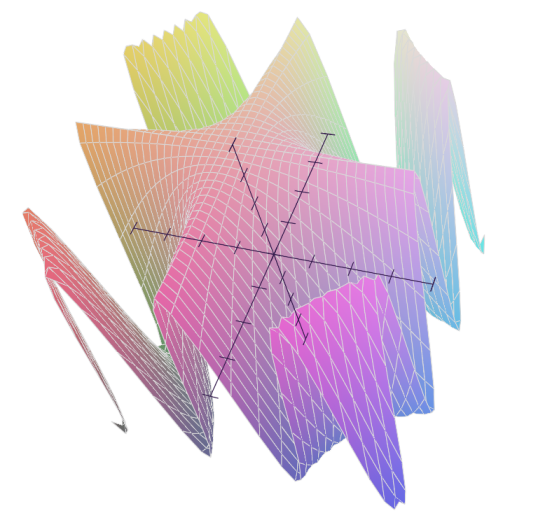
In [22]: Plot(1*x**2, [], [x], 'mode=cylindrical') # [unbound_theta,0,2*Pi,40], [x,-1,1,20]
Out[22]: [0]: x**2, 'mode=cylindrical'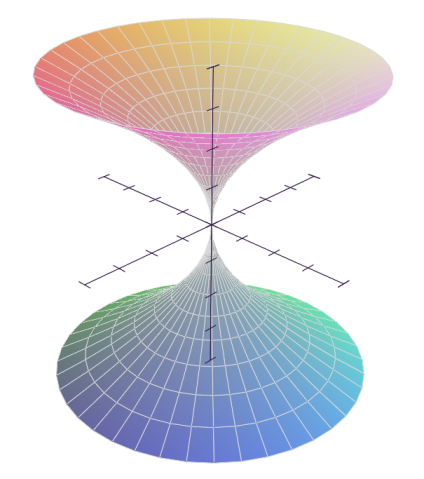
Yacas
There are two methods of plotting in Yacas:
- Plot2D(f(x), a:b) function
- Plot3DS(f(x,y), a:b, c:d) function
Plot2D(f, range, option=value) performs adaptive plotting of one or several functions of one variable in the specified range.
In> Plot2D(Sin(x^4)+Cos(x^4), 0:2*Pi)
Out> True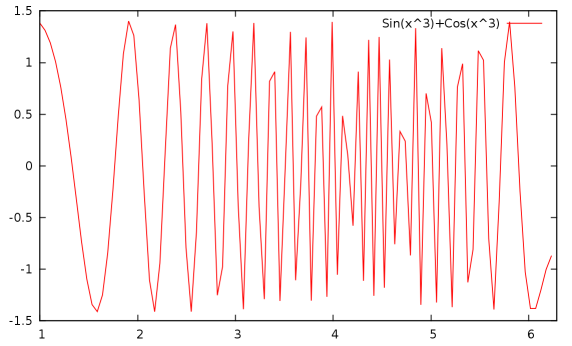
Plot3DS(f, range, option=value) performs adaptive plotting of two variables in the specified range.
In> Plot3DS(Sin(x*10)*Cos(y*5)-x*y, -1:1, -1:1)
Out> True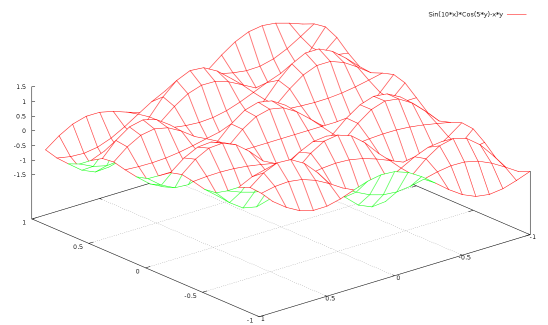
In> Plot3DS(Cos(x*y*10), -1:1, -1:1)
Out> True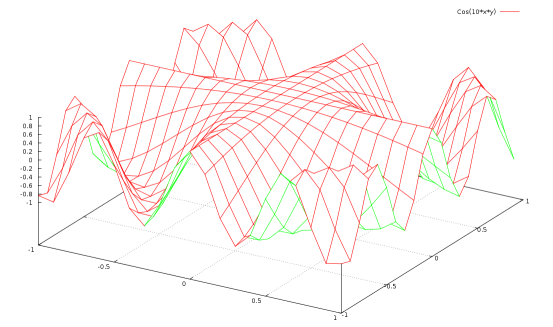
In> Plot3DS(ArcTan(y^3/4-x^2))
Out> True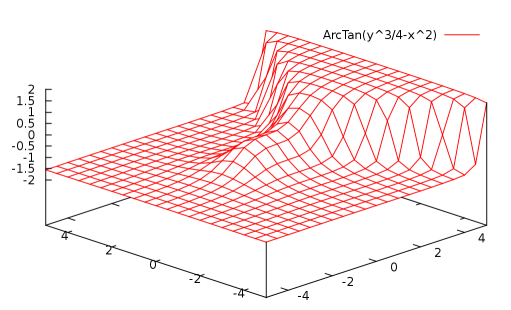
SymPy aims to be a lightweight normal Python module so as to become a nice open source alternative to Maple/Mathematica. Its goal is to be reasonably fast, easily extended with your own ideas, be callable from Python and could be used in real world problems. SymPy is perfectly multiplatform, it's small and easy to install and use, since it is written in pure Python (and doesn't need anything else).
Yacas's goal is to be a small system that allows to easily prototype and research symbolic mathematics algorithms. A secondary future goal is to evolve into a complete general purpose CAS.
You can choose to use either SymPy or Yacas, depending on what your needs are. For more information you can go to the official sites of SymPy and Yacas.